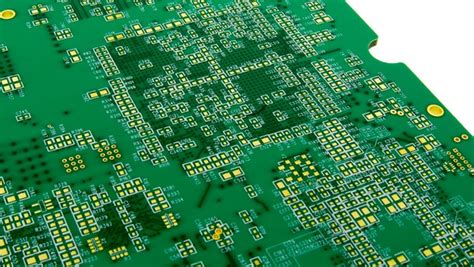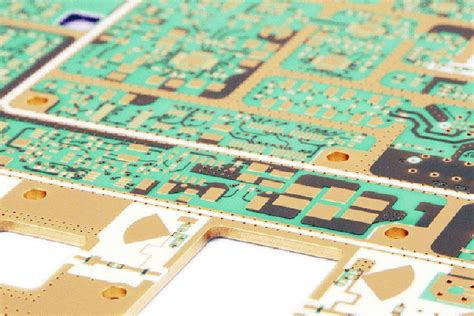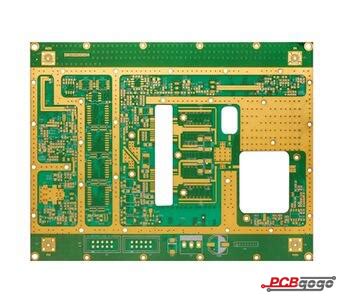Understanding the Importance of PCB material selection in RF Design
In RF applications, the PCB material plays a critical role in determining the electrical and mechanical properties of the circuit. The material’s dielectric constant (Dk), dissipation factor (Df), thermal conductivity, and mechanical stability are essential factors to consider. These properties affect signal propagation, loss, and Impedance matching, which are vital for maintaining signal integrity and minimizing losses in RF circuits.
Key Material Properties for RF PCBs
- Dielectric Constant (Dk)
- Dk represents the material’s ability to store electrical energy
- Lower Dk values are preferred for RF applications to minimize Signal Delay and improve signal speed
-
Consistent Dk across the frequency range is important for predictable performance
-
Dissipation Factor (Df)
- Df measures the material’s energy loss due to dielectric heating
- Lower Df values are desirable to minimize signal attenuation and power loss
-
Df should be stable across the operating frequency range
-
Thermal Conductivity
- Higher thermal conductivity helps dissipate heat generated by RF components
-
Effective heat dissipation prevents performance degradation and improves reliability
-
Mechanical Stability
- PCB material should have good dimensional stability and resist warping or deformation
- Stable mechanical properties ensure consistent performance over temperature and humidity variations
Popular PCB materials for RF Applications
Several PCB materials are commonly used in RF design, each with its own advantages and limitations. Let’s explore some of the most popular options:
1. FR-4
FR-4 is a widely used PCB material composed of woven fiberglass fabric impregnated with epoxy resin. While it is cost-effective and suitable for general-purpose PCBs, FR-4 has limitations in RF applications.
| Property | Value |
|---|---|
| Dielectric Constant (Dk) | 4.2 – 4.6 |
| Dissipation Factor (Df) | 0.02 |
| Thermal Conductivity | 0.3 W/mK |
| Frequency Range | Up to 2 GHz |
Advantages:
– Low cost
– Good mechanical strength
– Widely available
Disadvantages:
– Higher Dk and Df compared to specialized RF materials
– Limited frequency range
– Inconsistent performance at higher frequencies
2. Rogers RO4000 Series
The Rogers RO4000 series is a popular choice for RF applications due to its excellent electrical properties and consistent performance.
| Property | Value |
|---|---|
| Dielectric Constant (Dk) | 3.38 – 3.55 |
| Dissipation Factor (Df) | 0.0027 – 0.0037 |
| Thermal Conductivity | 0.6 – 0.7 W/mK |
| Frequency Range | Up to 40 GHz |
Advantages:
– Low Dk and Df values
– Stable performance over a wide frequency range
– Good thermal conductivity
– Excellent dimensional stability
Disadvantages:
– Higher cost compared to FR-4
– Limited availability and longer lead times
3. Taconic RF-35
Taconic RF-35 is another popular choice for RF applications, offering low loss and stable performance.
| Property | Value |
|---|---|
| Dielectric Constant (Dk) | 3.5 |
| Dissipation Factor (Df) | 0.0018 |
| Thermal Conductivity | 0.6 W/mK |
| Frequency Range | Up to 40 GHz |
Advantages:
– Low Dk and Df values
– Consistent performance over a wide frequency range
– Good thermal conductivity
– Excellent dimensional stability
Disadvantages:
– Higher cost compared to FR-4
– Limited availability and longer lead times
4. PTFE (Polytetrafluoroethylene)
PTFE, also known as Teflon, is a high-performance PCB material known for its excellent electrical properties and chemical resistance.
| Property | Value |
|---|---|
| Dielectric Constant (Dk) | 2.1 |
| Dissipation Factor (Df) | 0.0002 |
| Thermal Conductivity | 0.3 W/mK |
| Frequency Range | Up to 100 GHz |
Advantages:
– Extremely low Dk and Df values
– Wide operating frequency range
– Excellent chemical resistance
– Low moisture absorption
Disadvantages:
– High cost
– Challenging to manufacture due to soft and flexible nature
– Limited thermal conductivity

Factors to Consider When Selecting PCB Material for RF
When choosing a PCB material for your RF application, consider the following factors:
- Frequency Range
- Determine the operating frequency range of your RF circuit
-
Select a material that offers stable performance over the desired frequency range
-
Signal Integrity
- Prioritize materials with low Dk and Df values to minimize signal loss and distortion
-
Consider the material’s impact on impedance matching and signal propagation
-
Power Handling
- Evaluate the power requirements of your RF circuit
-
Choose a material with good thermal conductivity to dissipate heat effectively
-
Cost and Availability
- Consider the cost implications of different PCB materials
-
Ensure the selected material is readily available and aligns with your budget constraints
-
Manufacturing Considerations
- Assess the manufacturability of the chosen PCB material
- Collaborate with your PCB manufacturer to ensure compatibility with their processes

FAQ
-
Q: Can I use FR-4 for RF applications?
A: While FR-4 can be used for low-frequency RF applications, it is not recommended for high-frequency or performance-critical RF circuits due to its higher Dk and Df values and inconsistent performance at higher frequencies. -
Q: What is the main advantage of using Rogers RO4000 series for RF PCBs?
A: The Rogers RO4000 series offers low Dk and Df values, stable performance over a wide frequency range, good thermal conductivity, and excellent dimensional stability, making it a popular choice for RF applications. -
Q: Why is PTFE (Teflon) used in high-frequency RF applications?
A: PTFE has extremely low Dk and Df values, making it suitable for high-frequency RF applications up to 100 GHz. It also offers excellent chemical resistance and low moisture absorption. -
Q: How does the dielectric constant (Dk) affect RF performance?
A: A lower dielectric constant is preferred for RF applications as it minimizes signal delay, improves signal speed, and helps maintain consistent performance across the frequency range. -
Q: What should I consider when selecting a PCB material for my RF design?
A: When selecting a PCB material for RF, consider the operating frequency range, signal integrity requirements, power handling needs, cost and availability constraints, and manufacturability aspects. Collaborate with your PCB manufacturer to ensure compatibility with their processes.

Conclusion
Selecting the right PCB material is crucial for achieving optimal performance in RF applications. By understanding the key material properties and considering factors such as frequency range, signal integrity, power handling, cost, and manufacturability, designers can make informed decisions when choosing PCB materials for their RF circuits.
Popular PCB materials for RF include FR-4, Rogers RO4000 series, Taconic RF-35, and PTFE (Teflon), each with its own advantages and limitations. It is essential to evaluate the specific requirements of your RF application and consult with PCB manufacturers to ensure the selected material aligns with your design goals and manufacturing processes.
By carefully selecting the appropriate PCB material for your RF design, you can achieve stable performance, minimize signal loss, and ensure the overall success of your RF circuit.

No responses yet